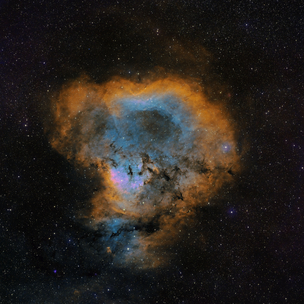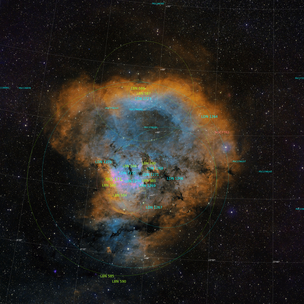CED 214
0
13
CED 214
Cederblad 214 (Ced 214) is an emission nebula located in the constellation Cepheus. It is part of the larger NGC 7822 complex, which is actually the northernmost emission nebula in the sky. Ced 214 is about 2,900 light-years away from Earth.
The nebula is named after Swedish astronomer Sven Cederblad, who compiled a catalog of diffuse nebulae in the Milky Way in 1946. Ced 214 is one of the brightest nebulae in the Cederblad catalog.
The nebula is a region of active star formation, and it contains a number of young stars. One of the most notable stars in Ced 214 is BD+66 1673, which is one of the hottest stars in our stellar neighborhood. BD+66 1673 has a temperature of almost 45,000 degrees Kelvin and shines 100,000 times brighter than the Sun.
The nebula is also home to a number of Bok globules, which are dense clouds of gas and dust that are in the process of collapsing to form stars. Bok globules are often referred to as "the building blocks of stars."
Ced 214 is a beautiful and fascinating object, and it is a popular target for amateur astronomers. The nebula is best observed in the winter months, when it is high in the sky.
Here are some additional facts about Cederblad 214:
It is about 150 light-years across.
It has a mass of about 10,000 solar masses.
The nebula is illuminated by the young stars within it.
The nebula is still forming stars.
It is a popular target for amateur astronomers.
The nebula is named after Swedish astronomer Sven Cederblad, who compiled a catalog of diffuse nebulae in the Milky Way in 1946. Ced 214 is one of the brightest nebulae in the Cederblad catalog.
The nebula is a region of active star formation, and it contains a number of young stars. One of the most notable stars in Ced 214 is BD+66 1673, which is one of the hottest stars in our stellar neighborhood. BD+66 1673 has a temperature of almost 45,000 degrees Kelvin and shines 100,000 times brighter than the Sun.
The nebula is also home to a number of Bok globules, which are dense clouds of gas and dust that are in the process of collapsing to form stars. Bok globules are often referred to as "the building blocks of stars."
Ced 214 is a beautiful and fascinating object, and it is a popular target for amateur astronomers. The nebula is best observed in the winter months, when it is high in the sky.
Here are some additional facts about Cederblad 214:
It is about 150 light-years across.
It has a mass of about 10,000 solar masses.
The nebula is illuminated by the young stars within it.
The nebula is still forming stars.
It is a popular target for amateur astronomers.
SPECIFICATIONS
Telescope
SPA-1
Camera
FLI PL16083
Location
Oria, Almería, Spain
Date of observation
Bundle
Filters
SHO
Processing
Pixinsight
Credits
Telescope Live/ Fred Zimmer





